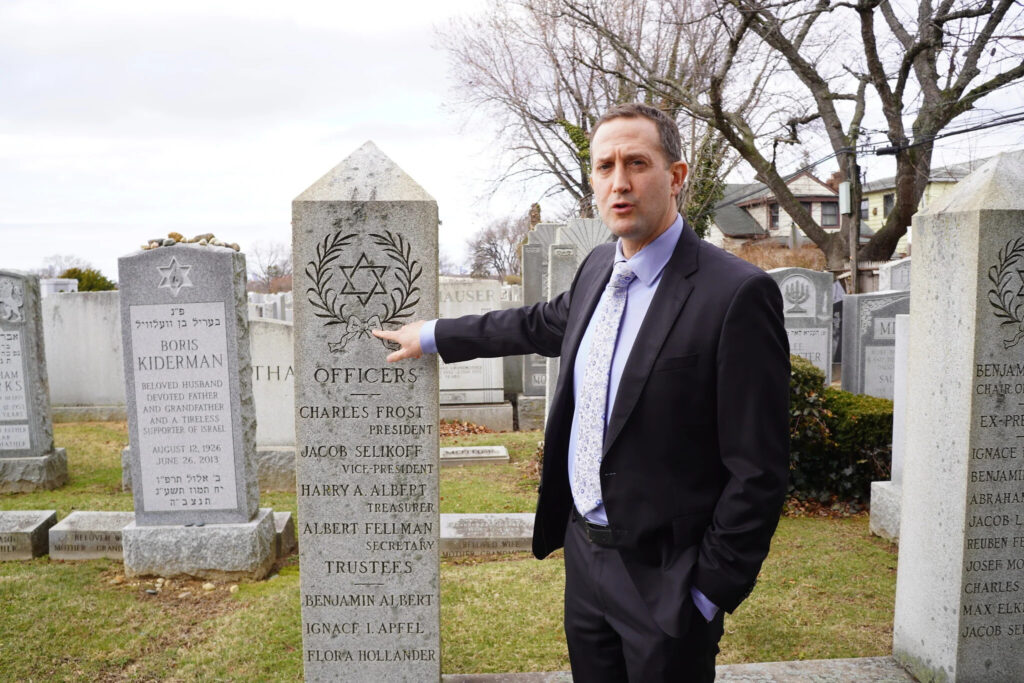Tucked between the hum of the Long Island Expressway and the flight path of LaGuardia Airport lies a hidden gem of Jewish American history—Mount Hebron Cemetery. Spanning 215 acres in Queens’ Kew Gardens Hills, it’s home to more than just gravestones. It’s a timeless archive of voices that once shaped the cultural, political, and spiritual fabric of New York—and beyond.
On a misty morning, cemetery head Adam Ginsberg strolls the tree-lined paths with his phone in hand. He pauses before the grave of David Medoff, a Ukrainian-born Yiddish tenor. With one tap, Medoff’s powerful voice rises through the quiet, singing “Song of Praise.” It’s one of many stops on Mount Hebron’s Yiddish Walk of Fame, a self-guided audio tour that brings the dead back to life—at least in spirit.

This isn’t your average cemetery tour. Mount Hebron’s Legacy Foundation, established in collaboration with CUNY Queens College, ensures that the 231,000 souls resting here aren’t forgotten. Through student-led research projects, biographies and forgotten histories resurface, revealing a kaleidoscope of narratives—from Holocaust survivors and war veterans to iconic rabbis, Broadway performers, and even mobsters.
“The stories here tell the remarkable contributions Jewish Americans have made to the city, the state, and the country,” says Ginsberg. And he’s not exaggerating.
City of Stones, City of Souls
Mount Hebron’s layout is something any urban planner would envy: neatly organized “society grounds” represent tight-knit communities, families, and organizations who chose to remain together, even in death. The Russian block features polished granite headstones with etched portraits. The Workman’s Circle section packs in over 10,000 markers, whispering of labor movements and immigrant dreams.
Near an elegant Art Deco mausoleum—built in 1988 for none other than Barbra Streisand—lie the final resting places of historic figures like Raphael Lemkin, the Polish Jewish lawyer who coined the word “genocide” and helped shape post-Holocaust justice.
And then there’s Rabbi Solomon Schechter, a leader of Conservative Judaism, and Hyman Matza, a WWII vet who helped liberate Dachau—though he never once bragged about it.
“He was just a sweet Jewish grandpa,” Ginsberg recalls. “Humble to the core.”
But Not All Were Saints
Mount Hebron doesn’t shy away from its more sinister stories. The Mob Tour—yes, that’s a thing—features the grave of Louis “Lepke” Buchalter, executed in 1944 for running a brutal Mafia hit squad. It’s a reminder that history isn’t always heroic, but it’s always human.
There’s even a Holocaust Memorial Tour that spans 14 stops, honoring entire towns in Ukraine, Poland, and Belarus whose Jewish populations were wiped out. Some monuments are painfully blunt: “Brutally persecuted and slain by the Nazis.” Others, like the Yiddish Theater section, mix performance and remembrance with messages etched in stone: “Dedicated to the eternal memory of the members of the European Yiddish theatrical profession who were murdered by the Nazis and other tyrants.”
A Living Place for the Dead
Despite the somber surroundings, Ginsberg sees his work as anything but morbid.
“People ask if it’s depressing,” he says. “But it’s not. It’s service. It’s history. It’s community.”
On Memorial and Veterans Day, local ROTC students plant flags at the graves of 2,500 Jewish veterans. The cemetery also hosts annual klezmer-filled ceremonies courtesy of the Yiddish Theater Alliance. And thanks to modern technology, anyone can walk the grounds with earbuds in, guided by voices from another time.
Final Thoughts
Mount Hebron is a cemetery, yes—but also a museum, a classroom, a concert hall, and at times, a crime documentary. Through its Walks of Fame and Infamy, it preserves the echoes of laughter, prayer, struggle, and song.
So next time you’re in Queens, take a moment to listen to those who came before. Because in Mount Hebron, the dead still have something to say.